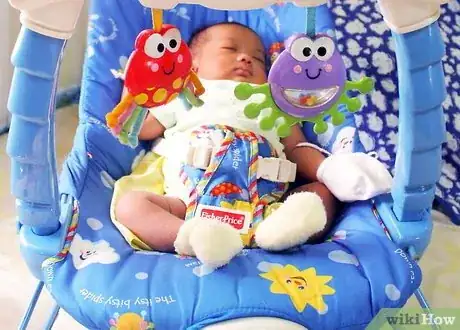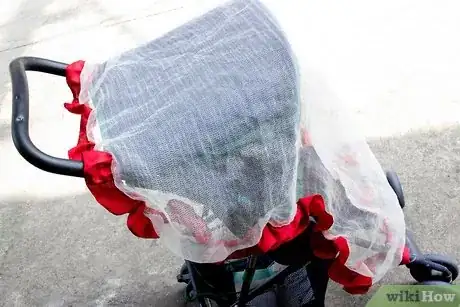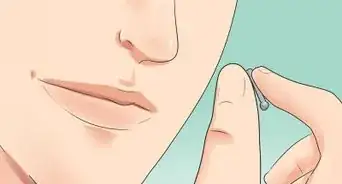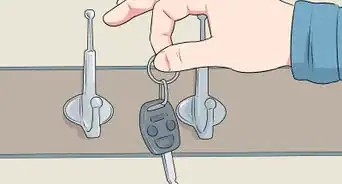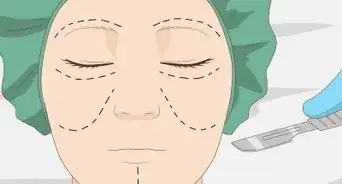This article was co-authored by Andrea Rudominer, MD, MPH. Dr. Andrea Rudominer is a board certified Pediatrician and Integrative Medicine Doctor based in the San Francisco Bay Area. Dr. Rudominer has over 15 years of medical care experience and specializes in preventive health care, obesity, adolescent care, ADHD, and culturally competent care. Dr. Rudominer received her MD from the University of California, Davis, and completed a residency at the Lucile Packard Children's Hospital at Stanford University. Dr. Rudominer also has an MPH in Maternal Child Health from the University of California, Berkeley. She is a Member of the American Board of Pediatrics, a Fellow of the American Academy of Pediatrics, a Member and Delegate of the California Medical Association, and a Member of the Santa Clara County Medical Association.
There are 14 references cited in this article, which can be found at the bottom of the page.
This article has been viewed 83,946 times.
Congratulations on entering into this wonderful new experience! Your new baby will be so small and completely dependent on you, which will probably make you feel equally responsible, determined, and terrified. Don't panic! Read below for some basic guidelines for taking care of your new baby, as well as links to helpful resources.
Steps
Handling Your Newborn
-
1Support your baby’s head. When you pick your baby up, be sure that you are supporting the head and neck. Babies have little muscle development in this area and if they do not have support when lifted, they can become seriously injured. Lift them delicately and cradle their head as you do so.
-
2Don’t worry too much about the soft spot. Babies skulls will not fully close until they are roughly a year and a half to two years old.[1] Until then, you will notice that there are soft spots on their head. Don’t worry too much, however. The membrane that covers these spots is very tough and your baby will be perfectly safe. You can touch these areas or comb the baby’s hair without causing any harm.
-
3Don’t ever shake your baby. Do not, under any circumstances, shake your baby. This will easily cause serious brain damage, spinal damage, or even kill your baby. You should not even shake them as a part of play until they have developed the muscles necessary to support this.
- If you are angry with your baby (which may very well happen, they cry a lot) and you are concerned that you feel the need to shake the baby or do something violent to make it be quiet, please seek help. Ask a friend or parent to watch the baby or give you advice until you calm down. Sleep deprivation is a harsh mistress.
Feeding Your Baby
-
1Understand when to feed your baby. Your baby will generally let you know when they need to be fed. Expect crying. With time you may come to be able to hear the difference between the cries and know which means hunger and which means bedtime and so on. How often they eat will depend on what they are eating, how much of it they are eating, and their own individual metabolism.
- Older babies will often give an indication when they are hungry, such as hand movements.
-
2Be conscious of what to feed your baby. Infants will need to drink milk, either from formula or breast milk. Try not to give them anything other than this, as it will likely make them sick or lead them to choke. They can eat baby food once they reach a few months old and as they start to get teeth you can introduce more solid foods.
-
3Know how to feed your baby. You will need to choose between bottles or breastfeeding. No matter which method you choose, you will need to ensure that you are doing it correctly in order to prevent your baby from getting an infection and to help decrease the likelihood of spitting up.
- If bottle feeding, you will need to decide between a variety of bottle types. You may wish to purchase simple, more cost-effective bottles or you may wish to purchase more complex ones. Bottle liners can be purchased if you want to reduce the amount of washing you’ll be doing, but you’ll make more garbage in exchange.
- Breastfeeding is incredibly simple. Women were born to do it, after all! Be sure that you are keeping your nipple clean and free of any infections. Consult with your doctor if you are taking any medications and check labels on over-the-counter drugs. You will also want to eat as healthfully as possible, since you will be sharing those nutrients with your baby!
- While there are a variety of acceptable feeding positions for either method, you may want to feed with the baby in an upright position, as this will help prevent spit up.
-
4Prepare for spit up. Babies stomach muscles are very weak in the beginning. So weak that sometimes they have a hard time keeping food in there! Don’t worry, this is very normal...it’s just messy. Prepare for spit up by always having rags handy in order to clean up the mess, keeping a bib on your baby when they’re a little bigger, and generally having a rag placed in front of your mouth any time you intend to burp them or move them around soon after eating.
- You will want to watch for spit up that is a color other than white or clear (red, yellow, green, and brown, for example) as these can be signs of illness. If you see this, take the baby to the doctor. Similarly, spitting up very forcefully or your baby not gaining weight are signs that would warrant a doctor’s visit.
-
5Burp your baby.[4] After your baby has eaten, you will want to burp them. They can easily swallow too much air while eating and the bubbles in their stomach will make them cranky and uncomfortable. Lay your baby so that they are slightly over your shoulder and then firmly pat their back. This will help release the air and make your baby very happy.
-
6Watch out for gas. If your baby seems very unhappy and you cannot find any other cause, they are likely gassy. Help them to work the gas out of their system by laying them across your lap on their stomach and with their butt slightly elevated. Pat their back and draw your hand downward to help work the gas out; gravity will do most of the work.
Ensuring Proper Hygiene
-
1Know when to change your baby’s diaper. This part won’t be too hard. If your baby’s diaper is filled, change it! If your baby’s diaper is wet, change it! A soiled diaper will smell, so it won’t be hard to tell when it’s time for a change. Wet diapers can be a little more challenging. Set a timer and be sure to at least check their diaper every two hours. If you notice it is wet before then, however, change it then.
- A baby should never be left in a soiled diaper for long, as this can lead to a wide range of health problems. Plus, it isn’t very sanitary for you! Very full diapers will leak and you probably don’t want poop in your carpets.
-
2Understand how to change your baby’s diaper. Diaper changing is very simple but if done incorrectly many problems can occur. Leaks, chafing, and pinching can result from an improperly placed diaper.[5] Follow a few simple guidelines to be sure that you are keeping yourself clean and your baby happy.
- Place your baby on the changing area, flat on their back. Do not leave them unattended in this area for any period of time and try to always have at least one hand on them to keep them from rolling away.
- Open the soiled diaper but do not take it all the way off.
- Clean your baby thoroughly with the appropriate wet wipes. Do this similarly to how you would clean yourself.
- Place the dirty wipes in the diaper and then, lifting the baby’s lower body up by the ankles, slide it out from under them. Roll it up and throw it away.
- Take out a fresh diaper, open it completely, and then slide it into position. Be sure that it is facing the correct direction.
- Close the diaper and check that the elastic around the legs is properly fit and is not too tight or pinching your baby.
-
3Combat diaper rash. Diaper rash is a common skin irritation that results when the baby’s skin cannot get dry, is rubbed too hard by the diaper, or when your baby has other health problems. It is often a result of not being changed enough or wearing a diaper that is too small, though it is easy to get diaper rashes and you should not feel bad if your baby gets one.[6]
- Combat diaper rash with the appropriate creams or powders when changing your baby’s diaper and change their diaper as soon as it is soiled.
- Make sure that diapers and your baby’s clothing fit, watch for dietary or product changes (as your baby may have an allergy), and be aware that antibiotics can make your baby susceptible to diaper rash. Seek help if the rash has not healed in a few days.
-
4Bathe your baby. Babies do not sweat like adults and so will not have to be bathed as often. Give them a bath once a week or after a particularly bad diaper. Use products that are labeled for babies and bathe them in a sink or baby bath. Never leave them unattended when they are in the water.[7]
- Sponge bathe infants until their umbilical cord has fallen off and any circumcision is healed.
-
5Don’t forget to brush “teeth”. Babies may not have teeth, but once they are a few months old you may want to start them brushing anyway. This will stimulate their gums and can help encourage teething.[8] Get baby toothbrushes, which are basically rubber brushes, and gently brush their gums once every few days.
Putting Your Baby to Sleep
-
1Be aware of when your baby sleeps. Babies do sleep a lot but not for very long periods of time. Each child will have it’s own natural sleep rhythm which you will learn with time. Try to accommodate it and plan your own sleep schedule as much as you can.
- Don't try to force your baby into a sleep schedule for at least the first couple of months. Just go with the flow, and remember your baby will only be this small for a short time.
- Do your best to sleep when your baby sleeps. Babies often have their days and nights mixed up, and it can be hard to function when you're sleep deprived.
-
2Know how to put your baby to sleep. Your baby may need help falling asleep, so know some basic ways to help your baby. You can hold your baby in your arms or up on your shoulder and either walk with them or rock them in a chair. Babies respond well to repetitive sounds, so make cooing sounds or you can sing them a lullaby.
-
3Understand swaddling. Swaddling is a method of wrapping up a baby in a blanket so that they don’t move. While it might seem strange to an adult, it is extremely comforting for a baby as it makes them feel secure. It will also keep them from surprising themselves if they move in their sleep. Watch the video below to learn how to swaddle your baby.
-
4Avoiding SIDS. SIDS, or sudden infant death syndrome, is a very mysterious condition which you will want to protect against. No one particularly understands what causes it and some question whether it exists at all, but there are a few practices which seem to be related to the deaths. Follow these simple rules and your baby should be fine:
- Protect your baby by always putting them to sleep on their back
- Don’t put a pacifier into your baby’s mouth
- Use a firm mattress in your baby’s crib
- Remove soft or fluffy bedding and stuffed animals
Playing with Him or Her
-
1Sit your baby in infant swings and seats. These will allow your baby to see the action going on around them, as well as a comfortable place to fall asleep if they get tired during the day. Try to get seats which bounce in response to your child’s movement and swings that can swing themselves. These will help keep baby entertained while you get things done. Just don’t leave them unattended!
-
2Let your baby play with toys. Once babies are old enough to hold objects, you can give them toys to play with. Get age appropriate toys that they can put in their mouths, as this is baby’s favorite way to play! Toys that make sounds or have lights are particularly fun for your baby.
- It is easy to make many toys that your baby can play from objects you find around the house. You do not need to spend a lot of money. For example, you can tie a bunch of plastic bags into a clean sock so that you have a soft ball which crinkled when you squish it. Baby will be fascinated!
-
3Sing to your baby. Sing your baby lots of songs. This will make them very happy, help the two of you bond, and will also help their brains develop. Sing songs that you like or children’s songs that you know! You will create memories to last a lifetime if you choose a song that is just for the two of you.
-
4Read with your baby. Read your baby lots of books. This will accommodate them to the idea of reading early on and will help their brains develop by exposing them to the rhythm and sounds of language. Make your reading entertaining by moving your hands across the page and using your “exciting” voice.
-
5Socialize your baby. Your baby will need to spend time around other children of a similar and different age. This will help your child learn to interact and be around others. Set up play-dates so that your baby gets to spend playtime with a friend. [9]
- Play with others in small groups. Your baby will become easily overwhelmed unless they are naturally very, very social so try to schedule play-dates with only one or two other children at a time.
- Let your baby watch you socialize. Your baby will learn a lot by watching you interact with your friends and other children. Relax while you are around other people, as your baby can pick up on your tension and may feel that other people should be feared. Be friendly and open and smile as you talk with other people. Hug them when it is appropriate. Your baby will learn that this is how we interact with others.
- Don’t be too protective. Your baby should be allowed to get into arguments with their friends. Even a little physical fighting is not unexpected. Try to let your baby sort these things out on their own, as this is how they learn to interact with other people. If you pick them up at the slightest sign of trouble then they will never learn.
Dealing with Illness
-
1Don’t stress about cradle cap. Cradle cap is a skin condition that is very normal for newborns. This will look like a scaly, yellow or white series of patches on their skin. It is not a serious condition and should resolve itself in a few months. If it seems overly severe, talk to your doctor.
-
2Look out for colds. Colds are normal in small children and should not be a cause for concern. Usually they will go away from two weeks. However, if your child is younger than 2-3 months, go to doctor as this can result in more serious health conditions.[10]
-
3Deal with thrush. Thrush is an oral yeast infection, usually a result of taking antibiotics. It will appear as whitish patches in and around the mouth or cracks at the corners of the mouth. Prevent thrush by keeping bottles and pacifiers clean. Though it is not a terribly threatening illness, if your child contracts thrush you should talk to your doctor to get the appropriate creams to treat the problem.[11]
Caring for Your Baby Outside
-
1Get a car seat. You will need to get a car seat before your baby is born, as one will be necessary to take your new baby home. Be sure to always use a car seat which is appropriate for the age and weight of your child. Rear-facing car seats are the safest and should be used until your child is at least 1 year old.
-
2Use a stroller or baby carrying wrap. You will want a method to carry your baby while you are shopping or out walking around. You can get a stroller and push them or, if you want to save space, carry your baby in a carrying wrap. These are perfectly comfortable for both of you and will also help you bond.
-
3Be careful where you take your newborn. Newborns have very weak immune systems and should be exposed to as little illness as possible. Do not take them to very crowded or dirty places, avoid other children’s birthday parties, and encourage others to touch the baby only on their feet (rather than the face or hands) to keep illness from spreading.
Expert Q&A
-
QuestionHow do I sleep if I have a newborn?
 Andrea Rudominer, MD, MPHDr. Andrea Rudominer is a board certified Pediatrician and Integrative Medicine Doctor based in the San Francisco Bay Area. Dr. Rudominer has over 15 years of medical care experience and specializes in preventive health care, obesity, adolescent care, ADHD, and culturally competent care. Dr. Rudominer received her MD from the University of California, Davis, and completed a residency at the Lucile Packard Children's Hospital at Stanford University. Dr. Rudominer also has an MPH in Maternal Child Health from the University of California, Berkeley. She is a Member of the American Board of Pediatrics, a Fellow of the American Academy of Pediatrics, a Member and Delegate of the California Medical Association, and a Member of the Santa Clara County Medical Association.
Andrea Rudominer, MD, MPHDr. Andrea Rudominer is a board certified Pediatrician and Integrative Medicine Doctor based in the San Francisco Bay Area. Dr. Rudominer has over 15 years of medical care experience and specializes in preventive health care, obesity, adolescent care, ADHD, and culturally competent care. Dr. Rudominer received her MD from the University of California, Davis, and completed a residency at the Lucile Packard Children's Hospital at Stanford University. Dr. Rudominer also has an MPH in Maternal Child Health from the University of California, Berkeley. She is a Member of the American Board of Pediatrics, a Fellow of the American Academy of Pediatrics, a Member and Delegate of the California Medical Association, and a Member of the Santa Clara County Medical Association.
Board Certified Pediatrician & Integrative Medicine Doctor Try to sleep when your baby sleeps. Babies often have their days and nights mixed up, so even if the baby is sleeping during the day, try to get in a nap. Don't worry about trying to figure out a schedule for at least the first couple of months. Also, don't try to get everything done—just take the time to rest and take care of yourself and your new baby.
Try to sleep when your baby sleeps. Babies often have their days and nights mixed up, so even if the baby is sleeping during the day, try to get in a nap. Don't worry about trying to figure out a schedule for at least the first couple of months. Also, don't try to get everything done—just take the time to rest and take care of yourself and your new baby.
References
- ↑ http://www.mayoclinic.com/health/healthy-baby/PR00043
- ↑ http://www.webmd.com/parenting/baby/breastfeeding-9/nursing-basics
- ↑ http://kidshealth.org/parent/growth/feeding/breast_bottle_feeding.html
- ↑ http://www.babycenter.com/0_how-to-burp-your-baby_10363676.bc
- ↑ http://www.babycenter.com/2_how-to-change-a-diaper_10347121.bc
- ↑ http://www.mayoclinic.com/health/diaper-rash/DS00069
- ↑ http://www.askdrsears.com/topics/skin-care/bathing-babies
- ↑ http://www.babycenter.com/0_how-to-care-for-your-babys-gums-and-emerging-teeth_126.bc
- ↑ http://www.parenting.com/article/the-social-life-of-babies
- ↑ http://www.parenting.com/article/dr-sears-guide-to-the-top-7-infant-illnesses?page=0,1
- ↑ http://www.babycenter.com/0_thrush-in-babies_92.bc
- http://www.nlm.nih.gov/medlineplus/infantandnewborncare.html
- http://kidshealth.org/parent/pregnancy_center/newborn_care/guide_parents.html#
- http://www.parents.com/baby/care/

















